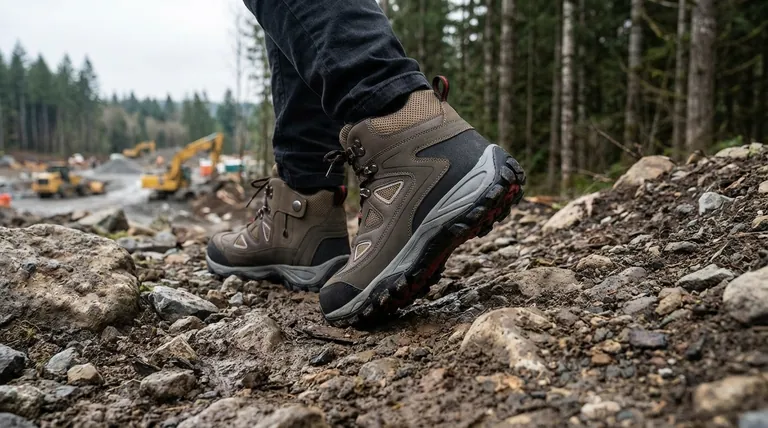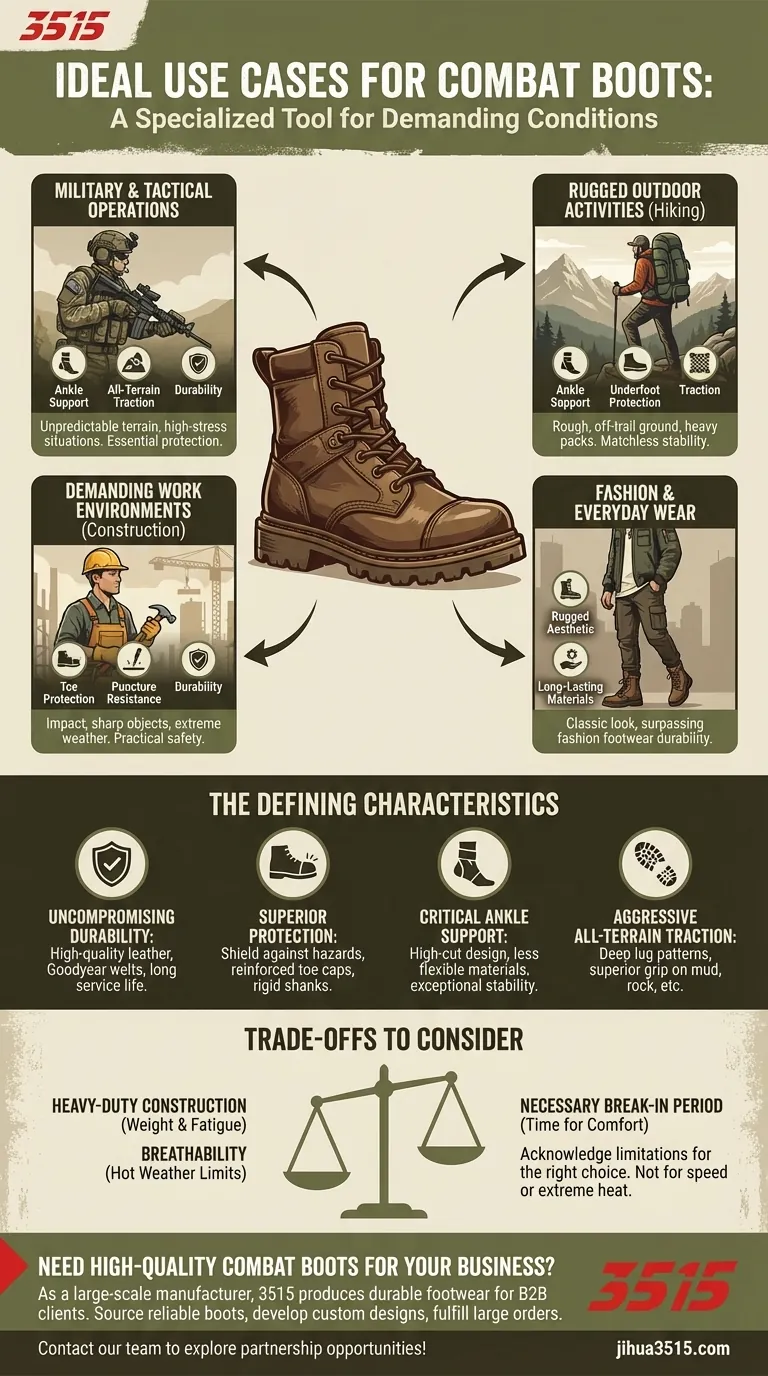At their core, combat boots are specialized tools. They are ideally suited for military operations, rugged outdoor activities like hiking, and demanding work environments where durability and protection are the absolute highest priorities. Their use extends to fashion, where their rugged aesthetic is valued.
The ideal use case for a combat boot isn't about a single activity, but a specific set of conditions. They excel in any environment where unwavering foot protection, critical ankle stability, and extreme durability are more important than low weight or flexibility.

The Defining Characteristics of a Combat Boot
To understand their best use, we must first understand how combat boots are engineered. They are built with a clear purpose, prioritizing function over all else.
Uncompromising Durability
Combat boots are constructed from high-quality leather and other strong materials designed to withstand heavy, repeated use in harsh conditions. Construction methods like Goodyear welts and heat-sealed soles ensure a long service life.
Superior Protection
A key feature is their ability to shield the foot from hazards. Many models include reinforced toe caps to protect against impacts and rigid shanks in the sole to guard against punctures from sharp objects.
Critical Ankle Support
The high-cut design is not just for style. It is intentionally built with less flexible materials to provide exceptional ankle stability, which is crucial for preventing injuries when navigating uneven or unpredictable terrain.
Aggressive All-Terrain Traction
Combat boots feature deep, aggressive lug patterns on their outsoles. This design provides a superior grip across a wide variety of surfaces, from mud and rock to slippery man-made floors.
Analyzing the Ideal Use Cases
These defining features make combat boots the right choice for several specific scenarios.
For Military and Tactical Operations
This is the environment for which combat boots were originally designed. The combination of protection, stability, and durability is essential for soldiers in high-stress situations where terrain and conditions are unpredictable.
For Rugged Outdoor Activities
For serious hikers and campers, combat boots offer a level of ankle support and underfoot protection that is hard to match. They are particularly well-suited for carrying heavy packs over rough, off-trail ground.
For Demanding Work Environments
In fields like construction, law enforcement, or forestry, the foot is constantly exposed to risks. The protective features of a combat boot guard against impacts, sharp objects, and extreme weather, making them a practical choice for safety.
For Style and Everyday Wear
The rugged, timeless look of combat boots has made them a staple in various subcultures and mainstream fashion. Here, the appeal is their classic aesthetic combined with a durability that far surpasses typical fashion footwear.
Understanding the Trade-offs
No single piece of footwear is perfect for every situation. Being a trusted advisor means acknowledging the limitations.
The Cost of Heavy-Duty Construction
Durability comes at the cost of weight. Combat boots are generally heavier than modern hiking boots or athletic shoes, which can lead to fatigue over very long distances.
Breathability in Hot Weather
The same features that protect you from the elements can work against you in extreme heat. The thick leather and protective membranes can limit airflow, making them a poor choice for hot, arid conditions unless specifically designed for that climate.
The Necessary Break-in Period
The stiff, supportive materials that protect your ankle require time to conform to your foot. Most high-quality combat boots will have a significant break-in period before they achieve maximum comfort.
Making the Right Choice for Your Needs
To decide if combat boots are right for you, evaluate your primary goal.
- If your primary focus is maximum protection and stability: Combat boots are an excellent choice for hazardous work, challenging terrain, or any activity where foot safety is paramount.
- If your primary focus is long-distance comfort or speed: A dedicated, lighter-weight hiking or running shoe will likely serve you better by reducing fatigue and offering more flexibility.
- If your primary focus is a rugged, long-lasting aesthetic: Combat boots provide a classic look and a level of durability that most fashion-oriented boots cannot match.
Understanding that the combat boot is first and foremost a tool for protection is the key to using it effectively.
Summary Table:
| Ideal Use Case | Key Boot Features Utilized |
|---|---|
| Military & Tactical Operations | Ankle Support, All-Terrain Traction, Durability |
| Rugged Outdoor Activities (Hiking) | Ankle Support, Underfoot Protection, Traction |
| Demanding Work Environments (Construction) | Toe Protection, Puncture Resistance, Durability |
| Fashion & Everyday Wear | Rugged Aesthetic, Long-Lasting Materials |
Need High-Quality Combat Boots for Your Business?
As a large-scale manufacturer, 3515 produces a comprehensive range of durable footwear for distributors, brand owners, and bulk clients. Our production capabilities encompass all types of military, tactical, and work boots designed for maximum protection and longevity.
We can help you:
- Source Reliable Footwear: Provide your customers with combat boots built to withstand the toughest conditions.
- Develop Custom Designs: Create unique boots tailored to your brand's specific needs and market.
- Fulfill Large Orders: Meet high-volume demands with consistent quality and competitive pricing.
Let's discuss your requirements. Contact our team today to explore partnership opportunities!
Visual Guide

Related Products
- Safety Footwear Wholesale Manufacturer for Custom OEM/ODM Production
- Wholesale Safety Footwear Manufacturer for Bulk & Custom OEM Orders
- Premium Wholesale Waterproof Safety Boots High Performance Protection for Industrial Markets
- High-Traction Suede Tactical Boots Wholesale & Custom Manufacturing
- Wholesale Customizable Safety Boots Durable & Protective Footwear Manufacturing
People Also Ask
- How do safety shoes contribute to cost savings for companies? A Strategic Investment in Risk and Cost Management
- Is it normal to wear shoes in the house? A Guide to Hygiene, Comfort & Culture
- How long can you wear safety boots? The Lifespan is Determined by Wear, Not Time
- Is safety-toe as good as steel toe? Choose the Right Protection for Your Job
- Do snake bite boots work? Your Ultimate Guide to Effective Snake Bite Protection



















